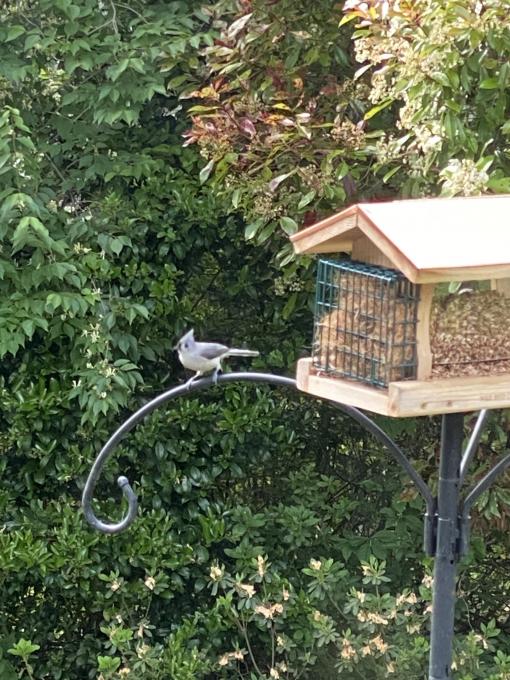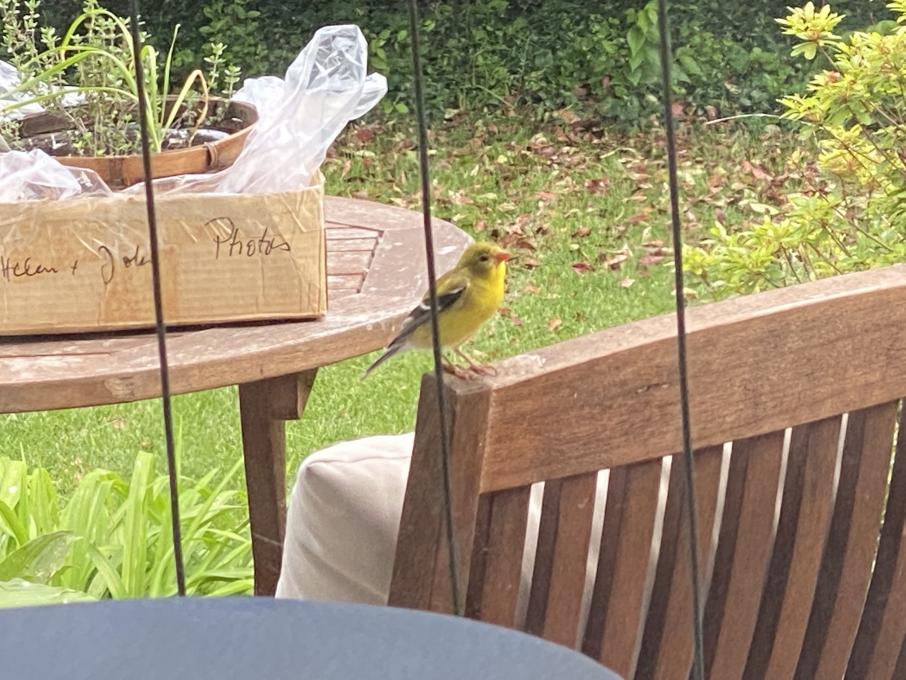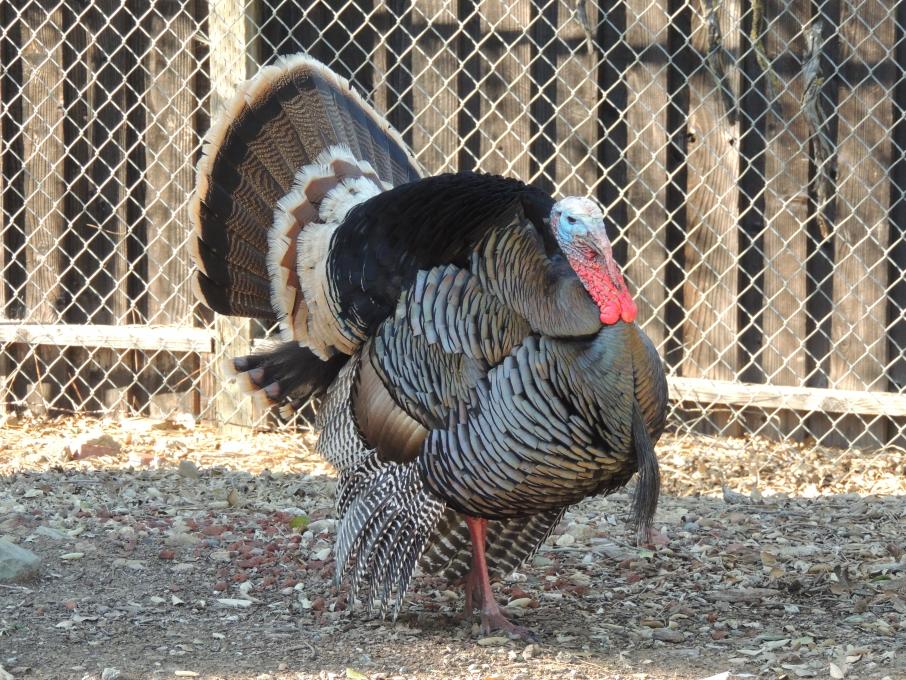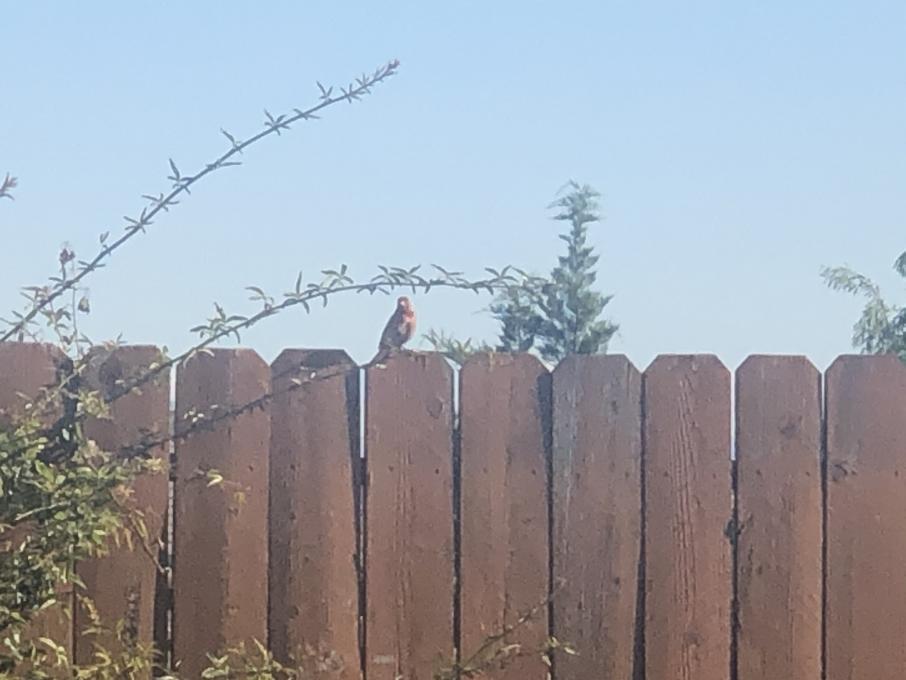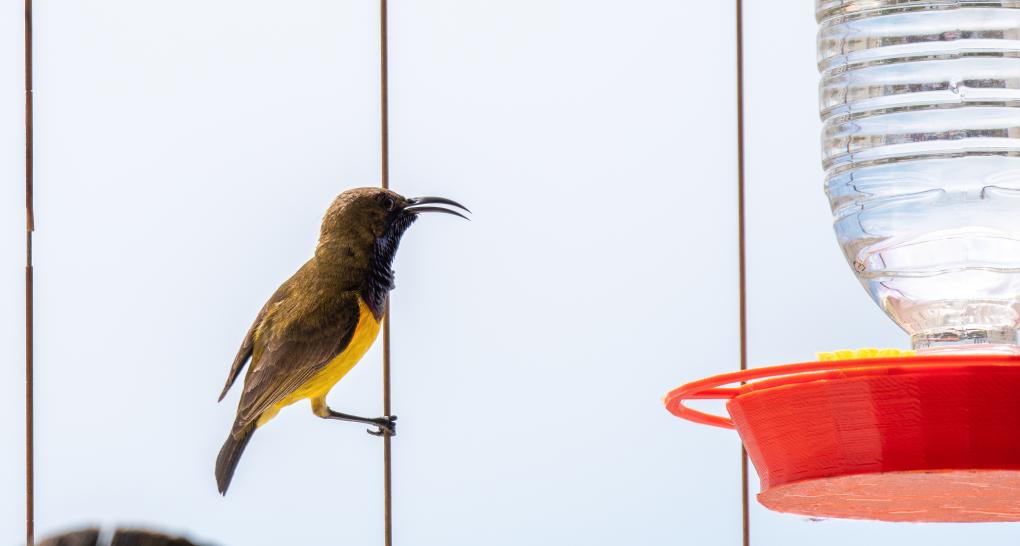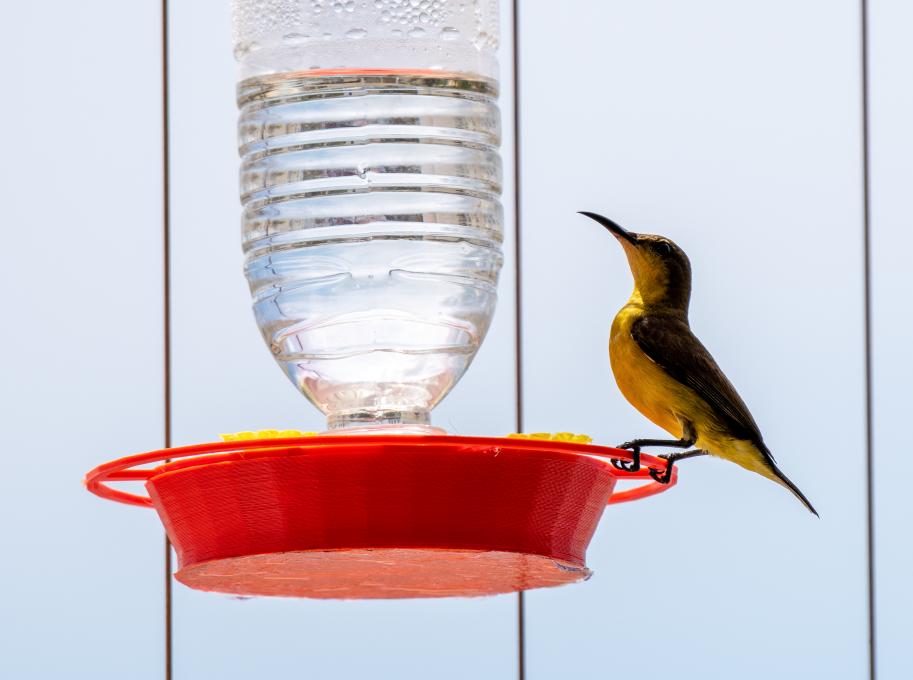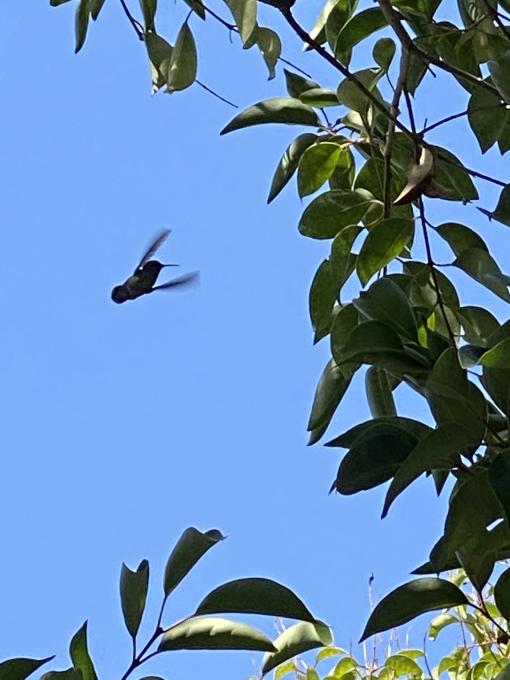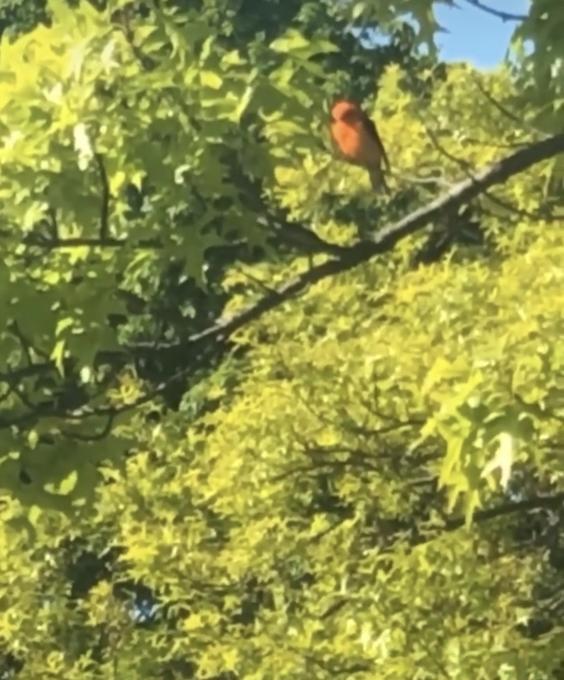The Cornell Lab Bird Academy › Discussion Groups › Joy of Birdwatching › Activities: Exploring Birds
-
Carolina wrens are reportedly present here in Boston neighborhood of Jamaica Plain but not sure I have seen one. am trying to learn call, Recently had a hawk right outside our kitchen window I think it was Broad shouldered hawk but not sure
-
I've been paying more attention to the birds in my yard, recently, and have seen 20 different types, in at least 4 groups. Robins, sparrows, Downy Woodpecker, Ruby throated Hummingbird pair, Cardinal to name a few. A new bird for me was a Indigo Bunting that was on my window feeder. It's hard say which bird is my favorite. I enjoy being able to ID them by sight or sound.
 I was able to lure a male Cardinal closer by using eBird audio!
I was able to lure a male Cardinal closer by using eBird audio! -
This is the Coopers Hawk I used to see (but not as much now, as the trees are all now leafy! BTW, i live in Mississauga Ontario. Sandra

-
There is a small woodlot abutting a local park that i go to during these Covid days. I found this little warbler and wonder if someone could tell me what it is. I'm surprised at what I found as it's a very busy location! There's also a Cooper's Hawk with a nest.. thank goodness, there was a birder watching me one day and told me what hawk I'd been seeing. Liking the bird course so far.. Sandra

-
Not sure, but looks like it might be a Golden-cheeked warbler based on the lack of streaking on the belly. If there is streaking that I’m just not seeing, could be a black-throated green warbler.
-
-
This morning in my backyard in Claremont CA, I saw: western scrub jay, mourning doves, band-tailed pigeon, house finch, monarch butterfly, mourning cloak, cabbage white, baby bunny. Hoping the black hooded oriole comes by for lunch again. It is 90* and no wind nor rain.
-
Activity 3--favorites in my neighborhood.
I never get tired of seeing great egrets in the ponds of my neighborhood. I associate them with early morning not only because that's when I usually see them but because they seem to match the still and calm of that time of day. So slender and elegant, and so very bright white. They're very zen. :) Another favorite that I often see in the same environment is the tree swallow. They're so much fun to watch--they dart, they circle, they buzz the surface of the water. If the light's not right, it's hard to see their beautiful color, but their head and shoulders are brilliantly blue and their fronts are gleaming white.
Honestly, though, almost any bird can be my favorite at the moment that I see it or hear it, especially when it's unexpected or when it's something I haven't encountered before. :)-
Tree swallows. . . In at least two public parks (here in
 southeast Michigan) it seems as though naturalists have erected nesting boxes that were intended for bluebirds but seem to be occupied by tree swallows.
southeast Michigan) it seems as though naturalists have erected nesting boxes that were intended for bluebirds but seem to be occupied by tree swallows. -
@Margaret We are in New York and watched a female bluebird confronting the tree swallows, in the nesting boxes. So interesting.
-
-
Lesson one was very helpful as we placed birds in groups. Now I can place birds in categories based on their description. As a new birder it is very difficult to identify birds. The bird that stood out on the Wall of Birds was the Hispaniolan Spindalis. I enjoyed observing the bird and placing it in a particular grouping. The grouping I chose was songbirds.
-
I had no clue how many different kinds of birds are in my neighborhood until I hung feeders and really started paying attention. Some of my favorites are the Carolina wrens, the tufted titmice (only just recently started visiting my feeders), the dark-eyed juncos (have stopped visiting my feeders now that its warm for some reason), the American goldfinches, the red-bellied woodpeckers, the white-breasted nuthatches... honestly it's hard to just pick a few favorites! Attaching a couple recent photos from my backyard.
We went to FL in February before everything really shut down and we visited the Flamingo Gardens. There were so many beautiful birds I'd never seen before! Attaching a photo from the bird sanctuary with some really cool looking wading birds.


-
My favorite bird on the Wall of Birds was probably the Lilac-breasted Roller. I liked the folklore that goes with it. And it's pretty! Around my house, I've been primarily seeing songbirds. So far this spring, I have been able to identify mountain chickadees, nuthatches, stellar's jays, robins, and a dark-eyed junco. I haven't gotten any good photos of them though. I did see a raptor the other day, but couldn't get a good look at it. I know that we get woodpeckers too, just haven't seen any yet this year. There were a couple hairy woodpeckers that spent all last summer in my backyard.
-
I just installed a bird feeder to my window where I am teleworking, and it has brightened up my days so much! I love watching the range of different characteristics and feeding habits of the birds- it is delightful to see them up close. One of the first visitors was a male house finch. Then, later in the week, he showed up with a female, and they have visited together several times. My other favorite is a male tufted titmouse, with his tiny grey crest-he has been a regular guest.
-
I really enjoy watching birds in my neighbourhood, especially Northern Flickers and Anna’s Hummingbirds. I like flickers because they’re so unlike other woodpeckers and have beautiful bright feather shafts in wings. Hummingbirds are just so cute and adorable! As I moved to Canada from Europe just a year ago, I can’t help getting fascinated by every bird I see around.
-
Staying safer in the mountains of North Carolina we have had fun getting to know the birds in our yard - old Friends like the Cardinal and Robin who both would be special if they weren't so common. We have a pair of Phoebe's who have looked into every window trying to get in the house. The ruby-throated hummingbird loved our irisis - now gone since they have gone. We have a Scarlet tanager high in the trees, a red-winged Blackbird who passed by for a day only. Our wood thrush came later than normal and I don't know if the brown-spotted belly bird was it or a brown thrasher. We hear our palliated woodpecker back, but haven't seen him yet. The wild turkeys come singularly or in groups. Guess that covers - songbirds, woodpeckers, hummingbirds, chicken-like birds. there have also been wrens and chickadees.
My favorite is the Phoebe because it is hanging around and I can get to know it.-
Glad you gave us a location for your narrative
-
-
ugly day here in Miami, raining all day. I still decided to go for a abbreviated bird walk with low expectations when it slowed down to drizzle. I was surprised to see a tree completely busy in the rain with a pair of downy woodpeckers which when I see I normally only see one,fighting? pair of red bellied woodpeckers and a pair of smaller blue jays in the same medium size tree. Does rain make birds more or less active?
-
From my deck, i often see downy woodpeckers, white throated sparrows and ravens.
Northern harriers are a favorite bird that are common in my neighbourhood. They are easy to identify because of their white rump patch and the way that they glide just above the trees and shrubs. I think a pair might be nesting nearby, since i've seen them a couple of times today. The female is darker, but the male's underside looks strikingly light colored, with black on his wingtips. I like the way they almost seem to float in the breeze as they glide along, and the elegant shape of their wings.-
Where is your neighborhood?
-
@Mavis I live just outside of Beaverlodge, a small town in northern Alberta. The area is a mix of farmland and forests, and you can see the edge of theRocky Mountains to the southwest.
-
-
I have been seeing a pileated woodpecker in my yard for a week or so now. I’m so excited because they are one of my favorites and rarely see them this close to home. What beautiful birds! My house finches continue to entertain us with their sweet songs and antics.
-
The pileated woodpecker fascinates me: it quite large and quite awkward, but strong!! We moved to a new location in suburban Montreal, and the other day I saw one as I looked out of my home-office window: just exploring the trunk of a multi-stemmed lilac. It is a bird I have actually seen quite frequently around here (and heard more often!), which surprises me, given the quite urban environment. Last Fall I saw one on a Hydro pole next to a busstop shelter--oblivious to the red light that had me stopped there. And just yesterday a hummingbird also streaked by my window--the first one I've seen in this area. All this (and the discussions between the cardinals and the blue jays in our cedar hedge :) give us some pleasure at the moment.
-
-
The Wild Turkey is not really my favorite bird, but this is one of my favorite bird photos. I live east of San Francisco Bay, where there a lot of wild turkeys. My wife and son and I saw a flock in a park. The hens and juveniles flew away when we approached, but this tom had no fear. He stood there and posed for us while we got within 10 feet to take the photo.

-
- Valerie
I have many Black birds in my yard on Cape Cod. I use to just think they were crows, ravens, or red wing blackbirds. I now realize I have many common grackles. I find them to be just stunning with their luminous heads and beautiful tails. I enjoy watching them fly, sing, and feed.-
No photo, just a reply. I had never seen a grackle until about a dozen years ago. I live in north central Utah, and apparently they were starting to move north (warming climate?). Now they are everywhere! They spend a lot of time in parking lots, but as was mentioned in the intro to this Academy, it is wonderful to see wildlife in the most mundane of places! The call or song of the grackles is so charming! I watched as a few of the grackles hopped under the cars and we're looking up to the under carriage, I guess to find useful ( to them) tidbits. Not only are they charming us with their songs, but they are keeping our parking lots clean, and even cleaning the undersides of our cars!
-
Activity 2 & 3:
Recent sitings
2 California quail at my local nursery
Several turkey vultures flying over the neighborhood
House Finches in the backyard. Here’s one male perched on my fence. I love the cheerful chirping. Love all finches!
-
We live in Singapore which is a city-state, with over 5 million inhabitants. Yet we have quite a selection of birds in the parks and nature reserves. We live on the 5th floor of a condominium and from our balcony we have been able to spot: Blue-throated Bee-eaters (see picture), Blue-tailed Bee-eaters, Dollar birds, Oriental Pied Hornbills, Coppersmith Barbets,Oriental Honey-buzzards,and more. These birds come and perch on unused TV antennas on the roofs just across our balcony. We also have a sun-bird feeder (same as hummingbird feeders as used in the americas) and get regular visits from a pair of Olive-backed Sunbirds (see pictures)



-
Looking at the Wall of Birds and watching an episode of Our Planet, I’m really fascinated by the Wandering Albatross. So huge and what a life! Watch the series. Great bird footage in the episodes I’ve seen so far.
-

This is a picture of an Anna's hummingbird taken from my patio in the Bay Area, which I feel lucky to get. I am also fascinated by Kingfishers (which we don't have many of in CA, but I enjoyed on the wall), Crows, Red-Wing Blackbirds, and my new friends are the bunch of Cedar Waxwings who put on a show in our neighborhood stripping a tree of its berries. They are so fast! -
From my living room in Crown Heights NYC, I spotted two scarlet tanagers (?) fluttering about--haven't seen either since.

-

I was so happy to be able to sit an watch these two Scarlet Honeyeaters on a bushwalk not far from my home during one of my iso-walks! They are Australia's smallest honeyeaters apparently, and they were indeed tiny. They didn't mind that I was sitting about a metre and a half away from them as they licked nectar from bottlebrush flowers. So very very pretty. -
My favorite bird here in the Chesapeake Bay are the Osprey and Great Blue Heron. They are abundant here. I learned that of the 100,00o mating pairs of Osprey in the US, 30,000 are living on the Bay. As a sailor, the return of the Osprey in the area fills my heart and lifts by spirit because they signal sailing season. :-) They are so magnificent to watch, building their nests and speed diving for fish. On the boat, we are able to get close enough to see the babies growing up over the season.
-
My husband and I went for a walk around the pond/wetland area in our neighborhood in Redding, CA and saw an osprey cruising overhead. That was a first and pretty magnificent. We usually see them by the Sacramento River.
-
-
I went on a short walk today to do this activity, and saw a red tail hawk, a bunch of robins and sparrows and grackles, a goldfinch, and I think an oriole (I couldn’t get close enough to get a good look.) I’m looking forward to improving my identification skills, especially recognizing songs.
But my favorite birds in my neighborhood are some plain old English sparrows who have a nest under the roof of my neighbor’s house, right at eye level from my apartment balcony. I know they can be bullies and they’re invasive, but I love watching this pair work together to build their nest. They have such great communication and such ingenuity. I’m really rooting for them!
Read More:
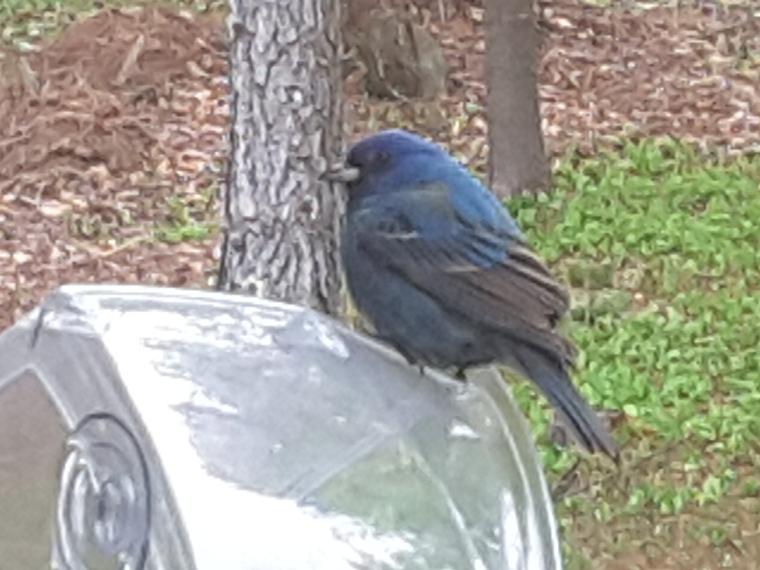 I was able to lure a male Cardinal closer by using eBird audio!
I was able to lure a male Cardinal closer by using eBird audio! 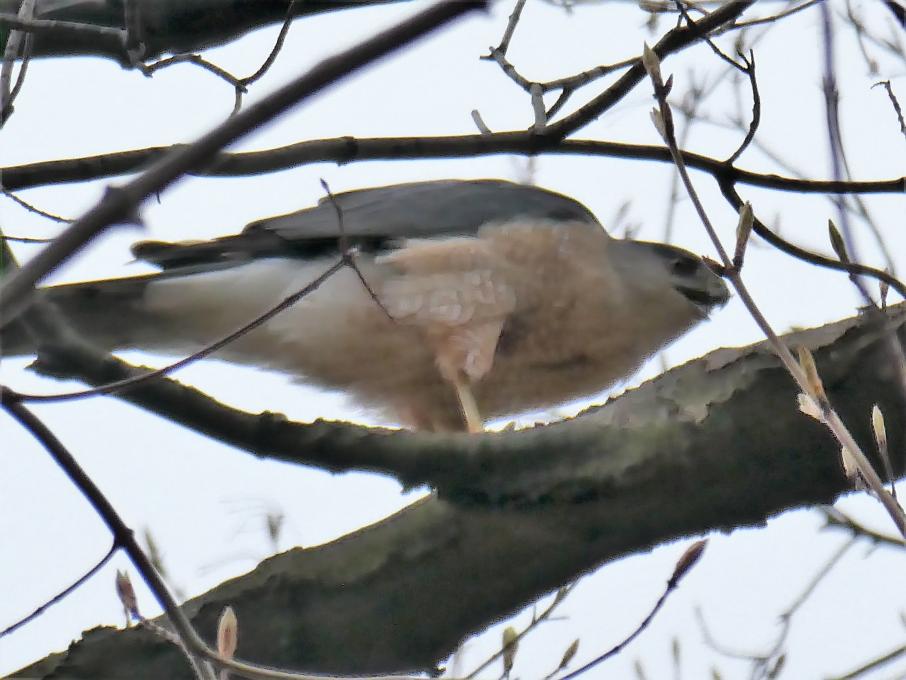
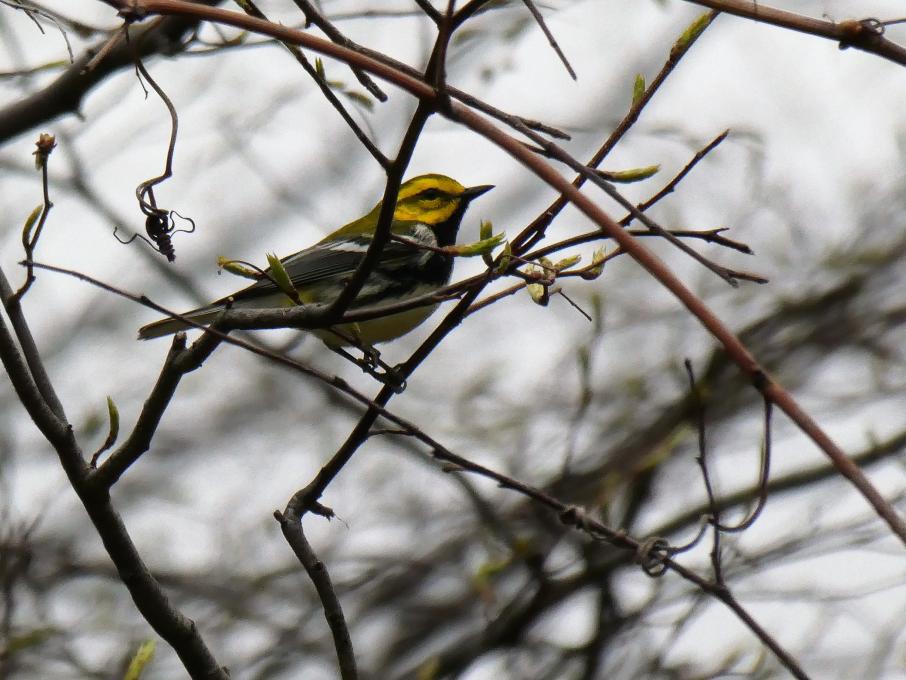
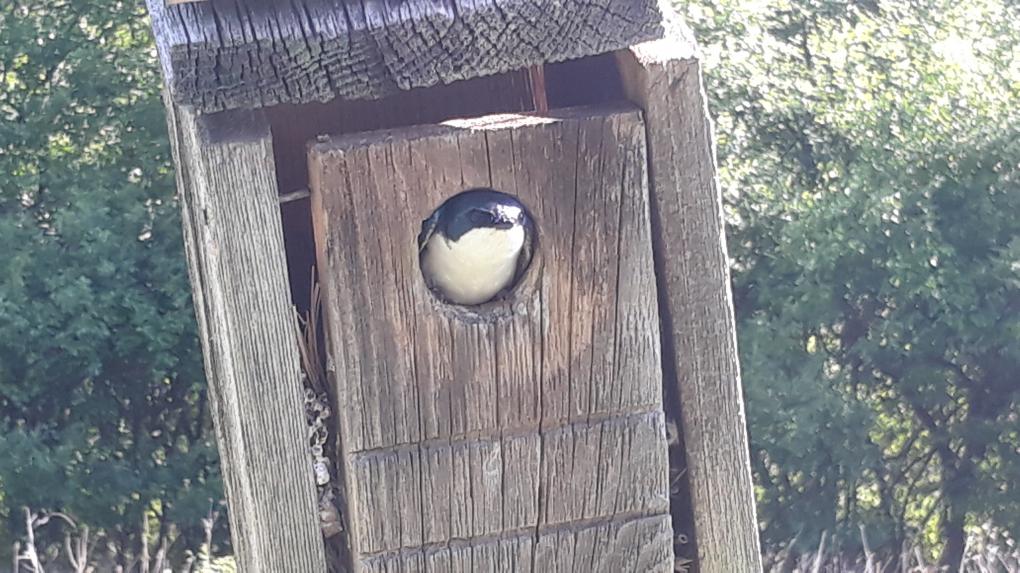 southeast Michigan) it seems as though naturalists have erected nesting boxes that were intended for bluebirds but seem to be occupied by tree swallows.
southeast Michigan) it seems as though naturalists have erected nesting boxes that were intended for bluebirds but seem to be occupied by tree swallows. 